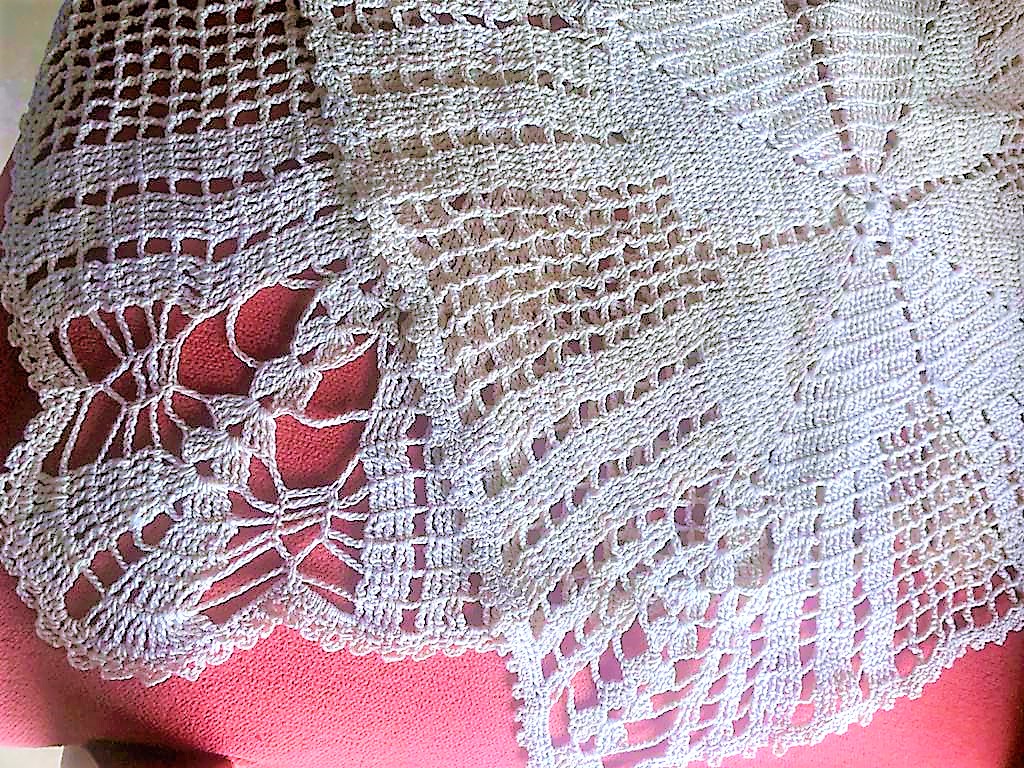
By Jelaine Foster
Raise a hand if growing up you owned a sewing machine – or a box – that had crochet and embroidery materials, needles and thread!
Again raise your hand if you own/owned various crochet, embroidery or knitted items (pillow cases, runners, tams, bed spreads, tea-cloths, pictures etc.)
Put up both hands if you know the difference between crochet and crochet braids.
Finally, raise the roof if you’ve ever knitted or crocheted a dress, pillow case or decorative piece.
Think of your grandparents, parents or family members and recall the decorative items commonly seen in their homes. Also, reflect on the activities that filled their spare time. Baking? Sewing? Gardening?
My mom baked the most delicious treats such as potato pudding, gizzada and plantain tarts. I also remember that she made me the cutest little nightgowns. She would painstakingly embroider a little doctor bird or a flower on each of them. When I studied “Clothing and Textile” at school she helped with my stitching.
Mommy showed me techniques which grandma taught her or those she learnt on her own. It was and still is the belief that young ladies should know how to sew – not merely to stick the needle in and out of the material. I plead guilty to that one.
The ability to do unique designs and express one’s creativity through crochet and embroidery was praiseworthy. I learnt about the passion behind such craft from Aunts Tiny and Merl.
Aunt Tiny still makes unique patterns on handkerchiefs (the dainty little ones women of a certain age tuck into their purses) and her house features a virtual exhibition of embroidered items.
She learnt the skill from her mother, who learnt from her mother, who, well I’m sure you can see where I’m heading.
It’s hard to think of Aunt Merl, and not picture her on her veranda with knitting and embroidery materials next to her – she says knitting relaxes her. For many hours she would be absorbed in her craft while keeping an eye on her favourite soap opera.
The origins of craft such as knitting can be traced to Europe where harsh winters demanded warm, protective clothing. It is believed that the expertise travelled across the ocean with immigrants to the New World.
Embroidery, knitting and crochet passed from one generation to the other if for no other reason than there were few other leisure activities. Beyond that, there was something personally satisfying to create something that was unique and perhaps admired by others.
Today there are few outlets for younger persons to learn craft. Schools which sometimes make the subject mandatory, still teach the art, but few people continue to practice after school.
But in North America, for example, hand embroidery is alive and well and surviving healthily in many places. From time to time there are even needlework shows which are heavily subscribed by enthusiasts.
There are good reasons why modern young people are not engaged in many of these activities. For one thing, it’s really easy to dash to a store and buy a crotched bathing suit, even easier to tap one’s fingers on a key board and make a purchase online and have it delivered to one’s door. It will not be the unique, classy garment that one could have had custom made, but it will fit the purpose.
Second, craft such as crochet and embroidery is time-consuming. Even though machine technology is gradually replacing the art of hand embroidery, there are so many activities competing for people’s attention these days.
The social revolution that has taken place over the last few years has rendered the traditional role of women obsolete. Women are now heads of household and therefore breadwinners, so unless they are doing craft as a commercial endeavor they really do not have the time to invest.
Though craft is not as popular as it was during the time of your parents and grandparents the desire for finished embroidery, knitting and crochet pieces is still alive. Blouses, blankets and bathing suits that are made using these techniques are becoming quite popular for their aesthetic value.
There are young women who I have interacted with who have taken up various craft as hobbies. One of my friends started knitting scarves because the craft relaxed her, kept her fingers active and she enjoyed showing off her creations.
If you’re interested in the art of crochet, knitting and embroidery but have no one to learn the skill from, simply YouTube it! It’s all laid out there.
Additionally, you can interact with like-minded people across the globe. There is even a crochet ministry online. A Crochet Ministry! Patterns and techniques are available and you can share your creations and ideas with a global community.
What makes these platforms even more awesome is that they have the potential to re-introduce Jamaican flair to the handmade industry. Instead of tourist coming here, buying items only to see ‘made in China’ tags, reintroducing the love for this art can pull more people into production so we can proudly display ‘made in Jamaica’ labels.
Let’s also support those who continue in the craft for their livelihood – the Craft Market downtown Kingston is still very much up and running.
Needlecraft is not a lost art, but it is hanging by a slim thread, pun intended. We need to guard it and use it as a continuation of bonding and making history. Plus, I hear that besides being a satisfying hobby it gives the fingers a massive work out!
Jelaine Foster, blogger, communicator, curiously asking: Would you consider embroidery and crochet a part of the Jamaican culture?